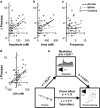Phasic mesolimbic dopamine signaling encodes the facilitation of incentive motivation produced by repeated cocaine exposure
- PMID: 24804846
- PMCID: PMC4138756
- DOI: 10.1038/npp.2014.96
Phasic mesolimbic dopamine signaling encodes the facilitation of incentive motivation produced by repeated cocaine exposure
Abstract
Drug addiction is marked by pathological drug seeking and intense drug craving, particularly in response to drug-related stimuli. Repeated psychostimulant administration is known to induce long-term alterations in mesolimbic dopamine (DA) signaling that are hypothesized to mediate this heightened sensitivity to environmental stimuli. However, there is little direct evidence that drug-induced alteration in mesolimbic DA function underlies this hypersensitivity to motivational cues. In the current study, we tested this hypothesis using fast-scan cyclic voltammetry to monitor phasic DA signaling in the nucleus accumbens core of cocaine-pretreated (6 once-daily injections of 15 mg/kg, i.p.) and drug-naive rats during a test of cue-evoked incentive motivation for food-the Pavlovian-to-instrumental transfer task. We found that prior cocaine exposure augmented both reward seeking and DA release triggered by the presentation of a reward-paired cue. Furthermore, cue-evoked DA signaling positively correlated with cue-evoked food seeking and was found to be a statistical mediator of this behavioral effect of cocaine. Taken together, these findings provide support for the hypothesis that repeated cocaine exposure enhances cue-evoked incentive motivation through augmented phasic mesolimbic DA signaling. This work sheds new light on a fundamental neurobiological mechanism underlying motivated behavior and its role in the expression of compulsive reward seeking.
Figures




Similar articles
-
Nucleus accumbens core dopamine signaling tracks the need-based motivational value of food-paired cues.J Neurochem. 2016 Mar;136(5):1026-36. doi: 10.1111/jnc.13494. Epub 2016 Jan 24. J Neurochem. 2016. PMID: 26715366 Free PMC article.
-
Cocaine Self-Administration Experience Induces Pathological Phasic Accumbens Dopamine Signals and Abnormal Incentive Behaviors in Drug-Abstinent Rats.J Neurosci. 2016 Jan 6;36(1):235-50. doi: 10.1523/JNEUROSCI.3468-15.2016. J Neurosci. 2016. PMID: 26740664 Free PMC article.
-
Phasic mesolimbic dopamine release tracks reward seeking during expression of Pavlovian-to-instrumental transfer.Biol Psychiatry. 2013 Apr 15;73(8):747-55. doi: 10.1016/j.biopsych.2012.12.005. Epub 2013 Jan 29. Biol Psychiatry. 2013. PMID: 23374641 Free PMC article.
-
Mesolimbic Dopamine and the Regulation of Motivated Behavior.Curr Top Behav Neurosci. 2016;27:231-57. doi: 10.1007/7854_2015_383. Curr Top Behav Neurosci. 2016. PMID: 26323245 Review.
-
Nucleus accumbens shell and core dopamine: differential role in behavior and addiction.Behav Brain Res. 2002 Dec 2;137(1-2):75-114. doi: 10.1016/s0166-4328(02)00286-3. Behav Brain Res. 2002. PMID: 12445717 Review.
Cited by
-
Repeated cocaine exposure dysregulates cognitive control over cue-evoked reward-seeking behavior during Pavlovian-to-instrumental transfer.Learn Mem. 2018 Aug 16;25(9):399-409. doi: 10.1101/lm.047621.118. Print 2018 Sep. Learn Mem. 2018. PMID: 30115761 Free PMC article.
-
Pornography Consumption and Cognitive-Affective Distress.J Nerv Ment Dis. 2023 Aug 1;211(8):641-646. doi: 10.1097/NMD.0000000000001669. J Nerv Ment Dis. 2023. PMID: 37505898 Free PMC article.
-
Generalized cue reactivity in rat dopamine neurons after opioids.Nat Commun. 2025 Jan 2;16(1):321. doi: 10.1038/s41467-024-55504-3. Nat Commun. 2025. PMID: 39747036 Free PMC article.
-
Brief intermittent cocaine self-administration and abstinence sensitizes cocaine effects on the dopamine transporter and increases drug seeking.Neuropsychopharmacology. 2015 Feb;40(3):728-35. doi: 10.1038/npp.2014.238. Epub 2014 Sep 12. Neuropsychopharmacology. 2015. PMID: 25212486 Free PMC article.
-
The role of the bed nucleus of the stria terminalis in the motivational control of instrumental action.Front Behav Neurosci. 2022 Nov 21;16:968593. doi: 10.3389/fnbeh.2022.968593. eCollection 2022. Front Behav Neurosci. 2022. PMID: 36478779 Free PMC article.
References
-
- Balleine BW, Ostlund SB. Still at the choice-point - action selection and initiation in instrumental conditioning. Ann N Y Acad Sci. 2007;1104:147–171. - PubMed
-
- Bassareo V, Cucca F, Cadoni C, Musio P, Di Chiara G. Differential influence of morphine sensitization on accumbens shell and core dopamine responses to morphine- and food-conditioned stimuli. Psychopharmacology (Berl) 2013;225:697–706. - PubMed
-
- Belin D, Belin-Rauscent A, Murray JE, Everitt BJ. Addiction: failure of control over maladaptive incentive habits. Curr Opin Neurobiol. 2013. - PubMed
Publication types
MeSH terms
Substances
Grants and funding
LinkOut - more resources
Full Text Sources
Other Literature Sources
Medical

